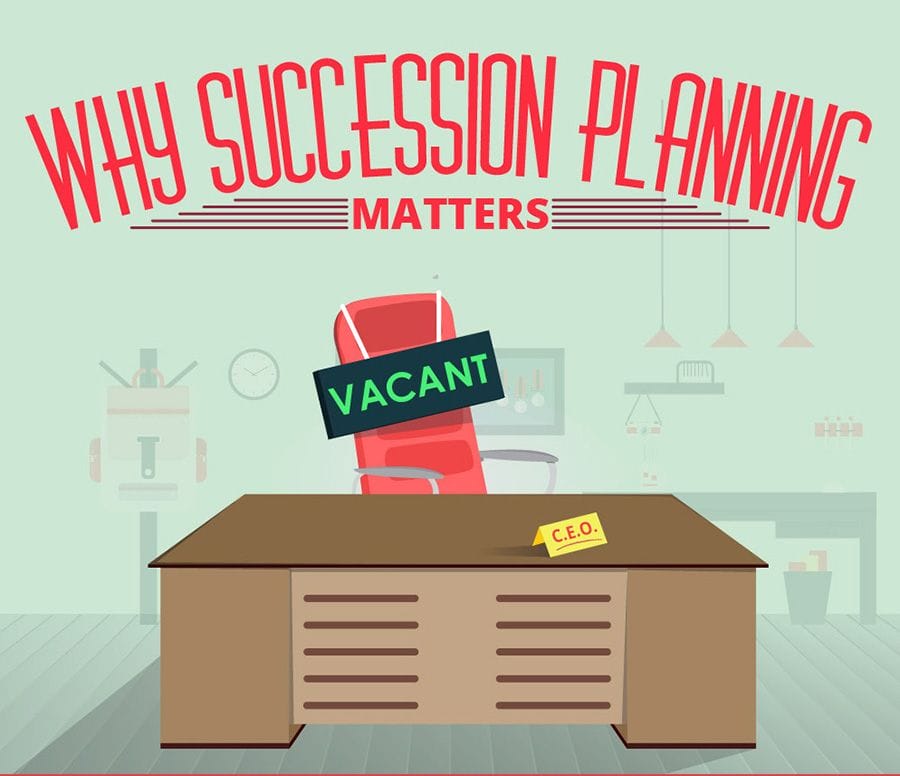Five Proven Employee Succession Planning Strategies

What is Employee Succession Planning?
Employee succession planning is a strategic process used by organizations to identify, develop, and prepare employees to fill key leadership roles when they become vacant. This proactive approach ensures business continuity, minimizes disruption, and fosters internal growth by focusing on workforce development. Unlike replacement planning, succession planning is an ongoing process that cultivates talent pipelines overtime and aligns workforce planning with corporate strategy. Effective succession planning safeguards against unexpected departures and enhances employee engagement, retention, and leadership development. Organizations that invest in succession are better equipped to handle shifts in leadership and drive long-term success.
Why is Succession Planning Important?
The need for skilled leaders and specialized talent is more critical than ever. Organizations without a robust succession strategy face significant risks, including operational disruptions and reduced employee morale.
By implementing a structured succession planning process, companies can groom internal talent for critical positions. This approach reduces hiring costs and fosters a culture of continuous learning. When succession is done right, employees perceive clear career growth opportunities.
Succession management also supports diversity and inclusion by providing equal opportunities for underrepresented talent to advance within the company. A strong succession strategy positions an organization for long-term stability and resilience in an increasingly competitive marketplace.
5 Strategies for Effective Employee Succession Planning and Management
1. Develop a Plan to Use During Any Instance of Succession
A well-defined succession management plan provides a clear roadmap for handling leadership transitions at any level. This plan should outline key roles, identify potential successors, and establish criteria for assessing readiness. Effective plans include short—and long-term strategies for talent development, leadership training, and contingency measures in case of unexpected departures. The plan should be evaluated regularly to address the changing needs of business, industry trends, and organizational growth. Leadership buy-in is essential to ensuring the plan’s success. Executives should actively participate in talent discussions, mentor high-potential employees, and support ongoing leadership development programs.
2. Consider the Company’s Specific Needs and Goals
Succession management is not a one-size-fits-all approach. Organizations must tailor their strategies to align with their unique business goals, industry demands, and culture. Understanding which competencies and skills are critical for success in key roles helps businesses make informed decisions when identifying potential successors. This information helps businesses cultivate talent that meets current and future needs.
3. Identify Positions That Require Specific Talent
Specific roles within an organization are crucial to maintaining business operations, company culture, and strategic direction. These positions should be prioritized in the succession management process. Start by identifying leadership roles that are hard to fill, technical positions that require extensive knowledge, and roles that contribute significant value to the company. Once these key positions are established, create a competency framework that outlines the skills, experience, and attributes needed for success in each role. By clearly defining role requirements, organizations can personalize training and development efforts with succession goals and timing.
4. Create a Succession Management Pool
An employee succession planning pool is a pipeline of high-potential employees who are being actively developed for leadership or critical roles. This approach goes beyond simply naming replacements and focuses on preparing multiple candidates for future opportunities. Organizations should assess employee potential based on performance, leadership capabilities, adaptability, and willingness to take on new challenges to build an adequate talent pool. Be sure to build a diverse and well-balanced succession pool. Having several capable candidates in the talent pool being developed for future leadership positions reduces reliance on external hires.
5. Continuously Assess Employee Performance
Ongoing performance evaluations are crucial in succession management. Regularly assessing employee progress helps organizations identify strengths, address development areas, and adjust succession plans accordingly. Performance assessments should incorporate qualitative and quantitative measures, including skills assessments, 360-degree feedback, and corporate objectives. By leveraging real-time data, businesses can make informed decisions about which employees are ready for advancement and which may require additional development. Transparent and constructive feedback mechanisms ensure employees understand their growth trajectories and feel motivated to work toward leadership roles.
Ok, here are a few more strategies for you:
6. Offer Opportunities for Professional Development
Investing in employee development strengthens the talent pipeline and prepares employees for future leadership opportunities. Providing structured learning programs, mentorship initiatives, and leadership training helps employees build the necessary competencies for succession. Lateral moves, cross-functional projects, and special assignments give employees hands-on experience in different aspects of the business, broadening their skill sets and enhancing their readiness for leadership roles. Encouraging employees to pursue certifications, higher education, and industry-specific training also contributes to career growth and succession preparedness. By fostering a culture of continuous learning, organizations will retain top talent and also build an agile workforce capable of driving business success.
7. Communicate Your Strategy for Promoting Internal Employees
Transparency in succession management is key to fostering employee trust and engagement. Do you plant to share who is in the talent pool and why? Communicating the company’s approach to internal promotions and leadership development builds trust with employees. Leaders should actively discuss career advancement opportunities during performance reviews and one-on-one meetings. Providing employees with clear career pathways, role expectations, and required competencies empowers them to take initiative in their development journey. Regular communication also reassures employees that the organization values internal growth, reducing turnover and increasing overall workforce morale.
8. Consider Succession Management During the Hiring Process
Effective succession management starts at the recruitment stage. Organizations should incorporate long-term talent planning into their hiring processes from the moment an offer is accepted. During recruitment, be sure to assess employee’s current skills early in the hiring process. This will help you match them to future roles that are strategic to the organization. Your onboarding program can be tailored to closing skill gaps critical to the company early on. It also helps new hires understand career progression opportunities and setting clear expectations for growth from day one.
Employee Succession Planning Software
Successful succession planning depends on retaining high potential talent and developing those employees so they are prepared to fill key roles. Development efforts often are based on well-defined individual career paths, which keep employees engaged and motivated to excel. However, even companies who don’t have a full-scale career pathing process can bolster succession planning efforts by focusing on honing the talent and leadership skills needed for each vital position. This can be accomplished in a variety of ways with use of succession planning tools.
- Constructive feedback tied to specific goals helps employees clearly measure their performance and adapt to meet new challenges. Unfortunately, only 23% of employees feel they are getting the feedback they need to excel. Companies who focus on providing regular and meaningful feedback to employees, however, see 3.6 times the level of engagement, which translates into higher retention rates—a vital component of successful succession planning.
- Lateral moves help high potential employees gain necessary skills for new roles by exposing them to varying tasks and responsibilities. Such moves also keep employees engaged by offering the opportunity to meet new challenges. Employees who make many lateral moves also obtain a big-picture view of the company as a whole—a perspective necessary for success in many top-level roles.
- Leadership roles like team lead build the kind of leadership skills an employee may need to succeed in future management roles or executive positions. They also promote confidence, a trait that makes employees more likely to speak up about new ideas.
- Special project assignments can build specific skill sets, as well as encourage self-direction and independent thought. They also can help fill identified skill gaps in an otherwise well-qualified candidate. Assignments like spearheading a new division or opening a branch in a new region may also serve as a trial run to see how a candidate might perform in a larger role.
- Internal and external training opportunities do more than train employees to be better workers. They also encourage retention. Two out of three employees say training plays an important role in their decision to stay with their employer. To be effective, however, training must be engaging. Research indicates that customizable, interactive training that allows employees to go at their own pace and review material already learned may be the most beneficial.
By investing in the development of high potential employees in any of these ways, companies ensure continual access to a talented and qualified pool of candidates for succession planning purposes. This enables a more robust planning process than creating a simple list of back-up candidates and ensures each person has the skills necessary to handle his or her new job when the time comes. For more information on employee succession planning, browse our Learning Center.
Wrap Up
Succession management is a critical strategy for organizations seeking long-term stability, resilience, and leadership continuity. Implementing these strategies ensures a comprehensive and practical approach to leadership development. It safeguards an organization’s future, enhances employee engagement, and drives sustainable business success. Investing in succession planning today builds the leaders of tomorrow.
For Effective Succession Management Strategies, view our Succession Planning Software page or request a demo.
Frequently Asked Questions
What are the 5 D’s of Succession Planning?
The 5 D’s of succession planning refer to the key scenarios that can impact leadership transitions and require a solid succession strategy. These are:
- Departure – A planned or unplanned exit of an employee from the organization, such as retirement or resignation.
- Death – The sudden passing of a key employee, which can leave a leadership vacuum if not planned for in advance.
- Disability – A situation where a leader is unable to perform their duties due to health or physical limitations.
- Divorce – In family-run businesses, personal issues such as divorce can impact company leadership and ownership structures.
- Disagreement – Conflicts within leadership or between stakeholders that may lead to a change in roles or departures.
By addressing these potential challenges in succession planning, organizations can ensure leadership continuity and minimize disruptions.
What is an Example of Succession Management?
A well-known example of succession management is Microsoft’s transition from Steve Ballmer to Satya Nadella as CEO. Microsoft had a clear succession strategy in place that identified and groomed internal talent, allowing for a seamless transition in leadership.
Another example is a mid-sized financial firm that proactively prepares future leaders by implementing a structured development program. The firm identifies high-potential employees, provides mentorship, and gives them exposure to various business functions. When a key leader retires, a well-prepared successor is ready to step in, ensuring business continuity and stability.
How Do You Structure a Succession Plan?
Structuring a succession plan involves several key steps to ensure an effective and sustainable leadership transition:
- Identify Key Roles – Determine which positions are critical to business success and require a succession plan.
- Assess Talent – Evaluate internal employees based on performance, leadership potential, and readiness to assume key roles.
- Develop Successors – Implement leadership training, mentorship programs, and rotational assignments to prepare future leaders.
- Create a Timeline – Establish a clear timeframe for succession, including planned retirements and potential emergency replacements.
- Document the Plan – Develop a formal succession strategy that outlines decision-making processes, leadership development initiatives, and contingency plans.
- Review and Update – Continuously reassess and refine the succession plan to align with evolving business needs and workforce changes.
By following these structured steps, organizations can build a robust employee succession planning strategy that ensures long-term leadership stability and organizational growth.
See a preview of TalentGuard’s platform
9-Box Talent Grid: How Transparent Should You Be?
Navigating Transparency and Expectations in the 9-Box Talent Grid The 9-Box Talent Grid is a powerful tool for assessing employees’ performance and potential. It comes with unique challenges for HR professionals who are new to the concept. One of the most significant challenges is managing employee expectations. When employees hear they’re part of the 9-Box […]
Critical Components of Succession Planning
Critical Components of Succession Planning At some critical point your focus needs to be on three key elements: the ‘Impact of Loss’, ‘Flight Risk’ and ‘Criticality to Retain’. These are essential components of Succession Planning. If you’re serious about achieving success through and with your best people, understanding how they impact your organization, both now and […]
Why Succession Planning Matters
Why Succession Planning Matters Succession planning is a critical component for the long-term success and stability of any organization, yet surprisingly, a recent study revealed that 50% of companies with revenue exceeding $500 million lack a proper CEO succession plan. This statistic highlights a significant vulnerability within large organizations, where the absence of a clear […]




